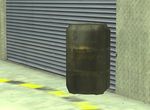Hydrogen: Difference between revisions
From Halopedia, the Halo wiki
m (→top: clean up, replaced: www.bungie.net → halo.bungie.net (2)) |
m (→top: clean up, replaced: {{SeeWikipedia → {{Wikipedia) |
||
| Line 1: | Line 1: | ||
{{Era|Forerunner|Covenant|Human|UNSC|HCW|Post}} | {{Era|Forerunner|Covenant|Human|UNSC|HCW|Post}} | ||
{{ | {{Wikipedia|Hydrogen}} | ||
[[Image:Hydrogen.jpg|thumb|150px|A barrel containing Hydrogen.]] | [[Image:Hydrogen.jpg|thumb|150px|A barrel containing Hydrogen.]] | ||
'''Hydrogen''' is a chemical element with an atomic number of 1; it is the first element in the Periodic Table and is the lightest with a molar mass of 1.00794 g/mol. It has an atomic radius of 78 pm. In its natural diatomic state, it is a colorless, odorless, tasteless gas. It is a very flammable gas and is the lightest element. Its low atomic number makes it a very common component in many reactions and molecules. | '''Hydrogen''' is a chemical element with an atomic number of 1; it is the first element in the Periodic Table and is the lightest with a molar mass of 1.00794 g/mol. It has an atomic radius of 78 pm. In its natural diatomic state, it is a colorless, odorless, tasteless gas. It is a very flammable gas and is the lightest element. Its low atomic number makes it a very common component in many reactions and molecules. | ||
Revision as of 03:37, September 17, 2018
| There is more information available on this subject at Hydrogen on the English Wikipedia. |
Hydrogen is a chemical element with an atomic number of 1; it is the first element in the Periodic Table and is the lightest with a molar mass of 1.00794 g/mol. It has an atomic radius of 78 pm. In its natural diatomic state, it is a colorless, odorless, tasteless gas. It is a very flammable gas and is the lightest element. Its low atomic number makes it a very common component in many reactions and molecules.
Hydrogen is the most common element in the entire universe because it makes up almost all stars (the rest of stars' mass is mostly helium). When purely combusted with oxygen, the (chemical equation 2H2 + O2 ---> 2H2O) it forms water and heat, a very useful reaction with a clean result.
As fossil fuels have largely been abandoned, hydrogen is one of humanity's current top power sources, commonly used in fuel cells and as fuel in fusion reactors along with deuterium. An example of a hydrogen-powered reactor is the reactor unit used to power prefabricated bases.[1] Hydrogen gas is also used to fuel some UNSC vehicles, such as the Warthog and Mongoose.[2][3]
